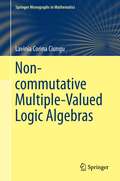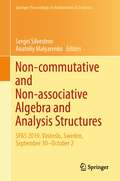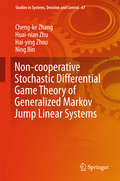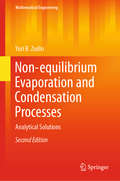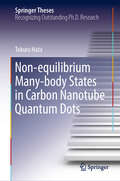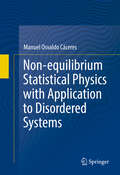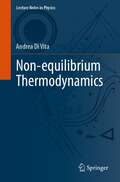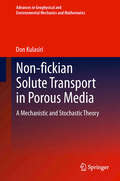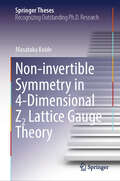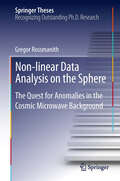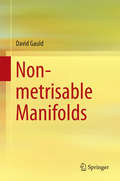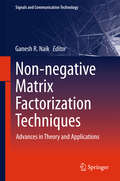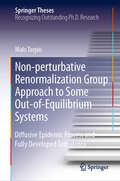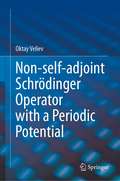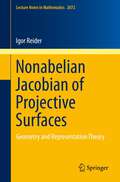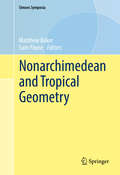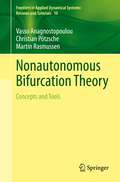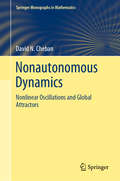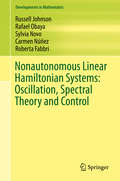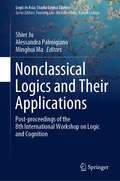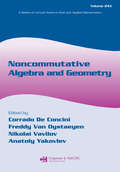- Table View
- List View
Non-commutative Multiple-Valued Logic Algebras
by Lavinia Corina CiunguThis monograph provides a self-contained and easy-to-read introduction to non-commutative multiple-valued logic algebras; a subject which has attracted much interest in the past few years because of its impact on information science, artificial intelligence and other subjects. A study of the newest results in the field, the monograph includes treatment of pseudo-BCK algebras, pseudo-hoops, residuated lattices, bounded divisible residuated lattices, pseudo-MTL algebras, pseudo-BL algebras and pseudo-MV algebras. It provides a fresh perspective on new trends in logic and algebras in that algebraic structures can be developed into fuzzy logics which connect quantum mechanics, mathematical logic, probability theory, algebra and soft computing. Written in a clear, concise and direct manner, Non-Commutative Multiple-Valued Logic Algebras will be of interest to masters and PhD students, as well as researchers in mathematical logic and theoretical computer science.
Non-commutative and Non-associative Algebra and Analysis Structures: SPAS 2019, Västerås, Sweden, September 30–October 2 (Springer Proceedings in Mathematics & Statistics #426)
by Anatoliy Malyarenko Sergei SilvestrovThe goal of the 2019 conference on Stochastic Processes and Algebraic Structures held in SPAS2019, Västerås, Sweden, from September 30th to October 2nd 2019 was to showcase the frontiers of research in several important topics of mathematics, mathematical statistics, and its applications. The conference has been organized along the following tracks: 1. Stochastic processes and modern statistical methods in theory and practice, 2. Engineering Mathematics, 3. Algebraic Structures and applications. This book highlights the latest advances in algebraic structures and applications focused on mathematical notions, methods, structures, concepts, problems, algorithms, and computational methods for the natural sciences, engineering, and modern technology. In particular, the book features mathematical methods and models from non-commutative and non-associative algebras and rings associated to generalizations of differential calculus, quantum deformations of algebras, Lie algebras, Lie superalgebras, color Lie algebras, Hom-algebras and their n-ary generalizations, semi-groups and group algebras, non-commutative and non-associative algebras and computational algebra interplay with q-special functions and q-analysis, topology, dynamical systems, representation theory, operator theory and functional analysis, applications of algebraic structures in coding theory, information analysis, geometry and probability theory. The book gathers selected, high-quality contributed chapters from several large research communities working on modern algebraic structures and their applications. The chapters cover both theory and applications, and are illustrated with a wealth of ideas, theorems, notions, proofs, examples, open problems, and results on the interplay of algebraic structures with other parts of Mathematics. The applications help readers grasp the material, and encourage them to develop new mathematical methods and concepts in their future research. Presenting new methods and results, reviews of cutting-edge research, open problems, and directions for future research, will serve as a source of inspiration for a broad range of researchers and students.
Non-cooperative Stochastic Differential Game Theory of Generalized Markov Jump Linear Systems
by Cheng-Ke Zhang Huai-Nian Zhu Hai-Ying Zhou Ning BinThis book systematically studies the stochastic non-cooperative differential game theory of generalized linear Markov jump systems and its application in the field of finance and insurance. The book is an in-depth research book of the continuous time and discrete time linear quadratic stochastic differential game, in order to establish a relatively complete framework of dynamic non-cooperative differential game theory. It uses the method of dynamic programming principle and Riccati equation, and derives it into all kinds of existence conditions and calculating method of the equilibrium strategies of dynamic non-cooperative differential game. Based on the game theory method, this book studies the corresponding robust control problem, especially the existence condition and design method of the optimal robust control strategy. The book discusses the theoretical results and its applications in the risk control, option pricing, and the optimal investment problem in the field of finance and insurance, enriching the achievements of differential game research. This book can be used as a reference book for non-cooperative differential game study, for graduate students majored in economic management, science and engineering of institutions of higher learning.
Non-equilibrium Evaporation and Condensation Processes: Analytical Solutions (Mathematical Engineering)
by Yuri B. ZudinThis monograph is focused mostly on the exposition of analytical methods for the solution of problems of strong phase change. A new theoretical model is proved useful in describing, with acceptable accuracy, problems of strong evaporation and condensation. The book is the first to treat the problem of asymmetry for evaporation/condensation. A semi-empirical model for the process is proposed for purposes of practical calculation of the process of strong evaporation. The “limiting schemes” of the vapor bubble growth are analyzed. The thermo-hydrodynamic problem of evaporating meniscus of a thin liquid film on a heated surface is considered. A theoretical analysis of the problem of evaporation of a drop levitating over a vapor cushion is performed. The problem of vapor condensation upon a transversal flow around a horizontal cylinder is considered. The second edition is extended by (i) the conjugate “strong evaporation - heat conduction” problem, (ii) the influence of accommodation coefficients on intensive processes of evaporation and condensation, (iii) the problem of supersonic condensation. This book is the first to present a comprehensive theoretical approach of boiling problems: nucleate boiling, superfluid helium phase transition, similarity between pseudo-boiling and subcritical pressure nucleate boiling. The target audience primarily comprises research experts in the field of thermodynamics and fluid dynamics, but the book may also be beneficial for graduate students.
Non-equilibrium Many-body States in Carbon Nanotube Quantum Dots (Springer Theses)
by Tokuro HataThis book presents the first experiment revealing several unexplored non-equilibrium properties of quantum many-body states, and addresses the interplay between the Kondo effect and superconductivity by probing shot noise. In addition, it describes in detail nano-fabrication techniques for carbon nanotube quantum dots, and a measurement protocol and principle that probes both equilibrium and non-equilibrium quantum states of electrons. The book offers various reviews of topics in mesoscopic systems: shot noise measurement, carbon nanotube quantum dots, the Kondo effect in quantum dots, and quantum dots with superconducting leads, which are relevant to probing non-equilibrium physics. These reviews offer particularly valuable resources for readers interested in non-equilibrium physics in mesoscopic systems. Further, the cutting-edge experimental results presented will allow reader to catch up on a vital new trend in the field.
Non-equilibrium Statistical Physics with Application to Disordered Systems
by Manuel Osvaldo CáceresThis textbook is the result of the enhancement of several courses on non-equilibrium statistics, stochastic processes, stochastic differential equations, anomalous diffusion and disorder. The target audience includes students of physics, mathematics, biology, chemistry, and engineering at undergraduate and graduate level with a grasp of the basic elements of mathematics and physics of the fourth year of a typical undergraduate course. The little-known physical and mathematical concepts are described in sections and specific exercises throughout the text, as well as in appendices. Physical-mathematical motivation is the main driving force for the development of this text. It presents the academic topics of probability theory and stochastic processes as well as new educational aspects in the presentation of non-equilibrium statistical theory and stochastic differential equations.. In particular it discusses the problem of irreversibility in that context and the dynamics of Fokker-Planck. An introduction on fluctuations around metastable and unstable points are given. It also describes relaxation theory of non-stationary Markov periodic in time systems. The theory of finite and infinite transport in disordered networks, with a discussion of the issue of anomalous diffusion is introduced. Further, it provides the basis for establishing the relationship between quantum aspects of the theory of linear response and the calculation of diffusion coefficients in amorphous systems.
Non-equilibrium Thermodynamics (Lecture Notes in Physics #1007)
by Andrea Di VitaThe importance of thermodynamics, particularly its Second Principle, to all branches of science in which systems with very large numbers of particles are involved cannot be overstated. This book offers a panoramic view of non-equilibrium thermodynamics. Perhaps the two most attractive aspects of thermodynamic equilibrium are its stability and its independence from the specifics of the particular system involved. Does an equivalent exist for non-equilibrium thermodynamics? Many researchers have tried to describe such stability in the same way that the Second Principle describes the stability of thermodynamic equilibrium - and failed. Most of them invoked either entropy, or its production rate, or some modified version of it. In their efforts, however, those researchers have found a lot of useful stability criteria for far-from-equilibrium states. These criteria usually take the form of variational principles, in terms of the minimization or maximization of some quantity. The aim of this book is to discuss these variational principles by highlighting the role of macroscopic quantities. This book is aimed at a wider audience than those most often exposed to the criteria described, i.e., undergraduates in STEM, as well as the usual interested and invested professionals.
Non-fickian Solute Transport in Porous Media
by Don KulasiriThe advection-dispersion equation that is used to model the solute transport in a porous medium is based on the premise that the fluctuating components of the flow velocity, hence the fluxes, due to a porous matrix can be assumed to obey a relationship similar to Fick's law. This introduces phenomenological coefficients which are dependent on the scale of the experiments. This book presents an approach, based on sound theories of stochastic calculus and differential equations, which removes this basic premise. This leads to a multiscale theory with scale independent coefficients. This book illustrates this outcome with available data at different scales, from experimental laboratory scales to regional scales.
Non-fickian Solute Transport in Porous Media: A Mechanistic and Stochastic Theory (Advances in Geophysical and Environmental Mechanics and Mathematics)
by Don KulasiriThe advection-dispersion equation that is used to model the solute transport in a porous medium is based on the premise that the fluctuating components of the flow velocity, hence the fluxes, due to a porous matrix can be assumed to obey a relationship similar to Fick’s law. This introduces phenomenological coefficients which are dependent on the scale of the experiments. This book presents an approach, based on sound theories of stochastic calculus and differential equations, which removes this basic premise. This leads to a multiscale theory with scale independent coefficients. This book illustrates this outcome with available data at different scales, from experimental laboratory scales to regional scales.
Non-invertible Symmetry in 4-Dimensional Z2 Lattice Gauge Theory (Springer Theses)
by Masataka KoideThis book provides a method for concretely constructing defects that represent non-invertible symmetries in four-dimensional lattice gauge theory. In terms of generalized symmetry, a symmetry is considered to be equivalent to a topological operator whose value does not change even if the shape is topologically transformed. Even for models that lack symmetry in the traditional sense and are difficult to analyze, it is possible to analyze them as long as a generalized symmetry exists. Therefore, generalized symmetry is important for the non-perturbative analysis of quantum field theory. Some topological operators have no group structure, and the corresponding symmetries are called non-invertible symmetries. Concrete examples of non-invertible symmetries in higher-dimensional theories were discovered around 2020, and they have been actively studied as a field of generalized symmetries since then. This book explains the non-invertible symmetry represented by the Kramers-Wannier-Wegner duality, which was found firstly in a four-dimensional theory, represented by three-dimensional defects. This book is intended for those with preliminary knowledge of quantum field theory and statistical mechanics.
Non-linear Data Analysis on the Sphere
by Gregor RossmanithThis work deals with the search for signatures of non-Gaussianities in the cosmic microwave background (CMB). Probing Gaussianity in the CMB addresses one of the key questions in modern cosmology because it allows us to discriminate between different models of inflation, and thus concerns a fundamental part of the standard cosmological model. The basic goal here is to adapt complementary methods stemming from the field of complexity science to CMB data analysis. Two key concepts, namely the method of surrogates and estimators for local scaling properties, are applied to CMB data analysis. All results show strong non-Gaussianities and pronounced asymmetries. The consistency of the full sky and cut sky results shows convincingly for the first time that the influence of the Galactic plane is not responsible for these deviations from Gaussianity and isotropy. The findings seriously call into question predictions of isotropic cosmologies based on the widely accepted single field slow roll inflation model.
Non-metrisable Manifolds
by David GauldManifolds fall naturally into two classes depending on whether they can be fitted with a distance measuring function or not. The former, metrisable manifolds, and especially compact manifolds, have been intensively studied by topologists for over a century, whereas the latter, non-metrisable manifolds, are much more abundant but have a more modest history, having become of increasing interest only over the past 40 years or so. The first book on this topic, this book ranges from criteria for metrisability, dynamics on non-metrisable manifolds, Nyikos's Bagpipe Theorem and whether perfectly normal manifolds are metrisable to structures on manifolds, especially the abundance of exotic differential structures and the dearth of foliations on the long plane. A rigid foliation of the Euclidean plane is described. This book is intended for graduate students and mathematicians who are curious about manifolds beyond the metrisability wall, and especially the use of Set Theory as a tool.
Non-negative Matrix Factorization Techniques
by Ganesh R. NaikThis book collects new results, concepts and further developments of NMF. The open problems discussed include, e. g. in bioinformatics: NMF and its extensions applied to gene expression, sequence analysis, the functional characterization of genes, clustering and text mining etc. The research results previously scattered in different scientific journals and conference proceedings are methodically collected and presented in a unified form. While readers can read the book chapters sequentially, each chapter is also self-contained. This book can be a good reference work for researchers and engineers interested in NMF, and can also be used as a handbook for students and professionals seeking to gain a better understanding of the latest applications of NMF.
Non-perturbative Renormalization Group Approach to Some Out-of-Equilibrium Systems: Diffusive Epidemic Process and Fully Developed Turbulence (Springer Theses)
by Malo TarpinThis thesis presents the application of non-perturbative, or functional, renormalization group to study the physics of critical stationary states in systems out-of-equilibrium. Two different systems are thereby studied. The first system is the diffusive epidemic process, a stochastic process which models the propagation of an epidemic within a population. This model exhibits a phase transition peculiar to out-of-equilibrium, between a stationary state where the epidemic is extinct and one where it survives. The present study helps to clarify subtle issues about the underlying symmetries of this process and the possible universality classes of its phase transition. The second system is fully developed homogeneous isotropic and incompressible turbulence. The stationary state of this driven-dissipative system shows an energy cascade whose phenomenology is complex, with partial scale-invariance, intertwined with what is called intermittency. In this work, analytical expressions for the space-time dependence of multi-point correlation functions of the turbulent state in 2- and 3-D are derived. This result is noteworthy in that it does not rely on phenomenological input except from the Navier-Stokes equation and that it becomes exact in the physically relevant limit of large wave-numbers. The obtained correlation functions show how scale invariance is broken in a subtle way, related to intermittency corrections.
Non-self-adjoint Schrödinger Operator with a Periodic Potential
by Oktay VelievThis book gives a complete spectral analysis of the non-self-adjoint Schrödinger operator with a periodic complex-valued potential. Building from the investigation of the spectrum and spectral singularities and construction of the spectral expansion for the non-self-adjoint Schrödinger operator, the book features a complete spectral analysis of the Mathieu-Schrödinger operator and the Schrödinger operator with a parity-time (PT)-symmetric periodic optical potential. There currently exists no general spectral theorem for non-self-adjoint operators; the approaches in this book thus open up new possibilities for spectral analysis of some of the most important operators used in non-Hermitian quantum mechanics and optics. Featuring detailed proofs and a comprehensive treatment of the subject matter, the book is ideally suited for graduate students at the intersection of physics and mathematics.
Nonabelian Jacobian of Projective Surfaces
by Igor ReiderThe Jacobian of a smooth projective curve is undoubtedly one of the most remarkable and beautiful objects in algebraic geometry. This work is an attempt to develop an analogous theory for smooth projective surfaces - a theory of the nonabelian Jacobian of smooth projective surfaces. Just like its classical counterpart, our nonabelian Jacobian relates to vector bundles (of rank 2) on a surface as well as its Hilbert scheme of points. But it also comes equipped with the variation of Hodge-like structures, which produces a sheaf of reductive Lie algebras naturally attached to our Jacobian. This constitutes a nonabelian analogue of the (abelian) Lie algebra structure of the classical Jacobian. This feature naturally relates geometry of surfaces with the representation theory of reductive Lie algebras/groups. This work's main focus is on providing an in-depth study of various aspects of this relation. It presents a substantial body of evidence that the sheaf of Lie algebras on the nonabelian Jacobian is an efficient tool for using the representation theory to systematically address various algebro-geometric problems. It also shows how to construct new invariants of representation theoretic origin on smooth projective surfaces.
Nonarchimedean and Tropical Geometry
by Matthew Baker Sam PayneThisvolume grew out of two Simons Symposia on "Nonarchimedean and tropicalgeometry" which took place on the island of St. John in April 2013 and inPuerto Rico in February 2015. Each meeting gathered a small group of expertsworking near the interface between tropical geometry and nonarchimedeananalytic spaces for a series of inspiring and provocative lectures on cuttingedge research, interspersed with lively discussions and collaborative work insmall groups. The articles collected here, which include high-level surveys aswell as original research, mirror the main themes of the two Symposia. Topicscovered in this volume include: Differential forms and currents, andsolutions of Monge-Ampere type differential equations on Berkovich spaces andtheir skeletons; The homotopy types of nonarchimedean analytifications; The existence of "faithful tropicalizations" which encode the topology andgeometry of analytifications; Relations between nonarchimedean analyticspaces and algebraic geometry, including logarithmic schemes, birationalgeometry, and the geometry of algebraic curves; Extended notions oftropical varieties which relate to Huber's theory of adic spaces analogously tothe way that usual tropical varieties relate to Berkovich spaces; and Relationsbetween nonarchimedean geometry and combinatorics, including deep andfascinating connections between matroid theory, tropical geometry, and Hodgetheory.
NonasSociative Algebra and Its Applications: The Fourth International Conference (Lecture Notes In Pure And Applied Mathematics Ser. #Vol. 211)
by Jr. Roberto Costa Alexander Grishkov Henrique Guzzo Luiz A. PeresiA collection of lectures presented at the Fourth International Conference on Nonassociative Algebra and its Applications, held in Sao Paulo, Brazil. Topics in algebra theory include alternative, Bernstein, Jordan, lie, and Malcev algebras and superalgebras. The volume presents applications to population genetics theory, physics, and more.
Nonautonomous Bifurcation Theory: Concepts and Tools (Frontiers in Applied Dynamical Systems: Reviews and Tutorials)
by Christian Pötzsche Martin Rasmussen Vasso AnagnostopoulouBifurcation theory is a major topic in dynamical systems theory with profound applications. However, in contrast to autonomous dynamical systems, it is not clear what a bifurcation of a nonautonomous dynamical system actually is, and so far, various different approaches to describe qualitative changes have been suggested in the literature. The aim of this book is to provide a concise survey of the area and equip the reader with suitable tools to tackle nonautonomous problems. A review, discussion and comparison of several concepts of bifurcation is provided, and these are formulated in a unified notation and illustrated by means of comprehensible examples. Additionally, certain relevant tools needed in a corresponding analysis are presented.
Nonautonomous Dynamical Systems in the Life Sciences
by Peter E. Kloeden Christian PötzscheNonautonomous dynamics describes the qualitative behavior of evolutionary differential and difference equations, whose right-hand side is explicitly time dependent. Over recent years, the theory of such systems has developed into a highly active field related to, yet recognizably distinct from that of classical autonomous dynamical systems. This development was motivated by problems of applied mathematics, in particular in the life sciences where genuinely nonautonomous systems abound. The purpose of this monograph is to indicate through selected, representative examples how often nonautonomous systems occur in the life sciences and to outline the new concepts and tools from the theory of nonautonomous dynamical systems that are now available for their investigation.
Nonautonomous Dynamics: Nonlinear Oscillations and Global Attractors (Springer Monographs in Mathematics)
by David N. ChebanThis book emphasizes those topological methods (of dynamical systems) and theories that are useful in the study of different classes of nonautonomous evolutionary equations. The content is developed over six chapters, providing a thorough introduction to the techniques used in the Chapters III-VI described by Chapter I-II. The author gives a systematic treatment of the basic mathematical theory and constructive methods for Nonautonomous Dynamics. They show how these diverse topics are connected to other important parts of mathematics, including Topology, Functional Analysis and Qualitative Theory of Differential/Difference Equations. Throughout the book a nice balance is maintained between rigorous mathematics and applications (ordinary differential/difference equations, functional differential equations and partial difference equations). The primary readership includes graduate and PhD students and researchers in in the field of dynamical systems and their applications (control theory, economic dynamics, mathematical theory of climate, population dynamics, oscillation theory etc).
Nonautonomous Linear Hamiltonian Systems: Oscillation, Spectral Theory and Control
by Russell Johnson Rafael Obaya Sylvia Novo Carmen Núñez Roberta FabbriThis monograph contains an in-depth analysis of the dynamics given by a linear Hamiltonian system of general dimension with nonautonomous bounded and uniformly continuous coefficients, without other initial assumptions on time-recurrence. Particular attention is given to the oscillation properties of the solutions as well as to a spectral theory appropriate for such systems. The book contains extensions of results which are well known when the coefficients are autonomous or periodic, as well as in the nonautonomous two-dimensional case. However, a substantial part of the theory presented here is new even in those much simpler situations. The authors make systematic use of basic facts concerning Lagrange planes and symplectic matrices, and apply some fundamental methods of topological dynamics and ergodic theory. Among the tools used in the analysis, which include Lyapunov exponents, Weyl matrices, exponential dichotomy, and weak disconjugacy, a fundamental role is played by the rotation number for linear Hamiltonian systems of general dimension. The properties of all these objects form the basis for the study of several themes concerning linear-quadratic control problems, including the linear regulator property, the Kalman-Bucy filter, the infinite-horizon optimization problem, the nonautonomous version of the Yakubovich Frequency Theorem, and dissipativity in the Willems sense. The book will be useful for graduate students and researchers interested in nonautonomous differential equations; dynamical systems and ergodic theory; spectral theory of differential operators; and control theory.
Nonclassical Logics and Their Applications: Post-proceedings of the 8th International Workshop on Logic and Cognition (Logic in Asia: Studia Logica Library)
by Shier Ju Alessandra Palmigiano Minghui MaThis edited book focuses on non-classical logics and their applications, highlighting the rapid advances and the new perspectives that are emerging in this area. Non-classical logics are logical formalisms that violate or go beyond classical logic laws, and their specific features make them particularly suited to describing and reason about aspects of social interaction. The richness and diversity of non-classical logics mean that this area is a natural catalyst for ideas and insights from many different fields, from information theory to game theory and business science. This volume is the post-proceedings of the 8th International Conference on Logic and Cognition, held at Sun Yat-Sen University Institute of Logic and Cognition (ILC) in Guangzhou, China in December 2016. The conference series started in 2001, and is organized by the ILC, often in collaboration with various international research groups. This eighth installment was jointly organized by ILC and Alessandra Palmigiano's Applied Logic research group. The conference series aims to foster the development of effective logical tools to study social behavior from a philosophical, cognitive and formal perspective in order to challenge the field of logic in ways that open up new and exciting research directions.Chapter "The Category of Node-and-Choice Forms, with Subcategories for Choice-Sequence Forms and Choice-Set Forms" of this book is available open access under a CC BY 4.0 license at link.springer.com
Noncommutative Algebra and Geometry (Lecture Notes in Pure and Applied Mathematics)
by Ian MuehlenhausA valuable addition to the Lecture Notes in Pure and Applied Mathematics series, this reference results from a conference held in St. Petersburg, Russia, in honor of Dr. Z. Borevich. This volume is mainly devoted to the contributions related to the European Science Foundation workshop, organized under the framework of noncommuntative geometry and i
Noncommutative Deformation Theory (Chapman & Hall/CRC Monographs and Research Notes in Mathematics)
by Eivind Eriksen Olav Arnfinn Laudal Arvid SiqvelandNoncommutative Deformation Theory is aimed at mathematicians and physicists studying the local structure of moduli spaces in algebraic geometry. This book introduces a general theory of noncommutative deformations, with applications to the study of moduli spaces of representations of associative algebras and to quantum theory in physics. An essential part of this theory is the study of obstructions of liftings of representations using generalised (matric) Massey products. Suitable for researchers in algebraic geometry and mathematical physics interested in the workings of noncommutative algebraic geometry, it may also be useful for advanced graduate students in these fields.
